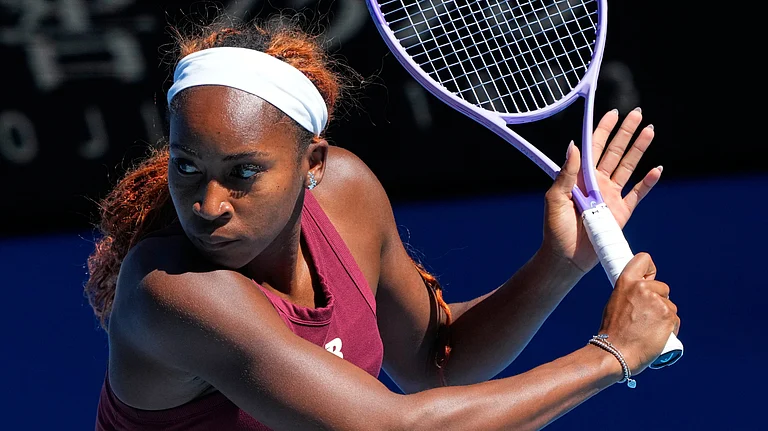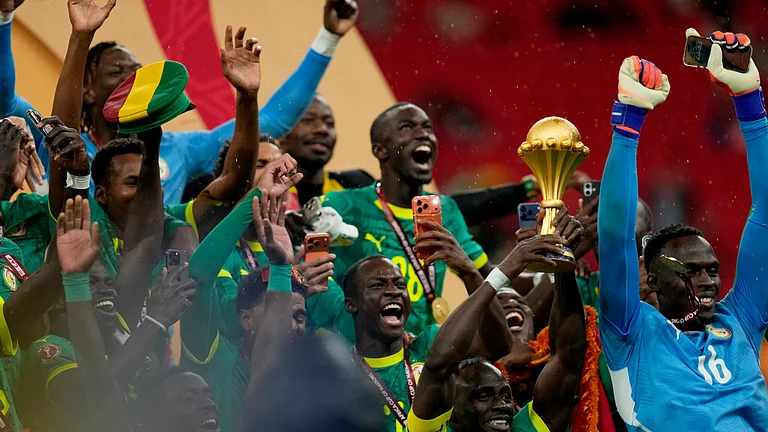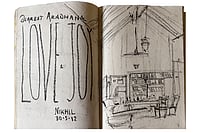“The news in those days was full of war and migrants and nativists, and it was full of fracturing too, of regions pulling away from nations, and cities pulling away from hinterlands, and it seemed that as everyone was coming together everyone was also moving apart. Without borders nations appeared to be becoming somewhat illusory, and people were questioning what role they had to play.”
—Mohsin Hamid, Exit West
“Fashion!
Turn to the left
Fashion!
Turn to the right
Oooh, fashion!
We are the goon squad and we’re coming to town
Beep-beep, beep-beep”
— Fashion by David Bowie
In that window across the apartment where I lived then, I saw a man pace up and down the living room and the bedroom in the evenings. Naked. The glass windows left him exposed. He never drew the curtains. Some nights, he would dress up and lie down on his bed. Face down. I realised then that his nakedness was a political statement. Who we are is a question of identity. We are living in fractured times. Clothes, at least the ones on the runways here, are not representative of anything around me. This is not a fashion story. It is rather a story of all the catastrophes that happened while fashion designers showed escape fantasies on the runway. To survive in a post-pandemic world, you probably might need to sell glitter and shine. But to stay relevant, fashion might need to be a push-back force, a disruption, a collective force. The great reset button has been pressed.
In those months of the first wave, I was out in the streets reporting, watching, listening. We wore PPE outfits, masks and face shields. I even drew the hammer and sickle on one. With lipstick. Clothes had been rendered irrelevant. At least to me. The rest were home. They said pyjamas and sweatpants were the new fashion things.
After all, we were interacting via the screen. That kind of interface left us feeling a bit incomplete, a bit strange and gave us some amount of freedom.
The thing was that salaries had been cut. People had nowhere to go. Weddings were happening online. We had nobody to meet except the poor on the streets, who had nowhere to go but home and so, they walked and walked. When you witness misery, something should change. And that something should change everywhere, trigger something, lead to something.
Fashion has a longstanding relationship with both social and personal identity.
Fashion, to me, has always been that intersection of a Venn diagram. It claims to be an art that is lived on a daily basis. It also has commercial concerns. Fashion weeks are meant for buyers, viewers and critics. Unfortunately, critics are lacking here. Everything by big designers is good. Their repetitions are their signature style. Their approach to the identity question, a mere mention. Or not even.
In such absence of everything, opulence could be this escape, this fantasy. But that’s not enough. Maybe that’s political too. But it isn’t political enough.
Is there an ellipsis after the fantasy tour? Or is there none? Either way, it is too far removed from everything that the world is going through.

Models: Kajal Chaudhary and Pupps Roy, who is queer and believes in claiming his space. Kajal is wearing Mohd Mazhar and Pupps is wearing his own clothes. Pupps’ makeup by Dinky Maggo, Kajal’s makeup by Nandini and hair by Sneha
Fashion in India has issues. It is time to talk about those. Tokenism is not the way out. It is not intelligent enough. So, there was that 377 moment in fashion with rainbow colours sashaying down the runway. That’s perhaps the most political Indian fashion has been. At least in my experience. The rest have been disastrous in their propaganda of an Indian identity that’s colourful. Nostalgia and memory are mere tropes in collections. Nothing is riveting. Nothing provokes. Nothing appeals.
“Indian” is also a lot of other things.
Culture belongs to all. Where am I, a single woman, in the bridal collections? Am I an outsider then? Unwanted guest at the grand Indian wedding?
In her essay ‘Dressing Left: Conforming, Transforming, and Shifting Masculine Style’ in Fashion Talks: Undressing the Power of Style, Shira Tarrant writes: “Gender is a continuum of identities and presentations of self. As such, there is no binary, there is no Other... The even larger question that remains unanswered is whether it is ever really possible that mainstream images of fashion and style can move beyond a binary of masculine and feminine in opposition to each other...”
***
In those days when the streets were so empty that you could do a slow dance on them, I wanted to wear a spacesuit, a protest tee with a red dot cut up in halves, a red beret, an armour. Something other than flowers cascading down the length and breadth of my clothes. I didn’t want to escape. I wanted to claim my place in this dystopian world. Clothes are an expression. It is an answer to that question of identity. In those days when the Prime Minister of this country asked people to stay home and clap and light diyas, I wondered about the homeless. Everything is a prophecy.
ALSO READ: Wanted! A Desi Model For Fashion Education
The “goon squad has come to town” and instead of fashion that also claims to be “art” becoming a push-back force, we are witnessing a surrender. This defeat is such a screeching halt. The problem with fashion and the ones who are its vanguards here is they are never outrageous. For many years now, the designers here are making trousseau for the modern, empowered bride. There is this fantasia and perhaps fantasia too is a political statement except there is never any such intent. Make flowers, make them glitter and become the self-proclaimed saviours of handloom, craft, this and that. Everything is photo op. Everything is “press release”.

I read more than a dozen in the flight on Tuesday. Travel, romance, escape. Same old. All jaded. The world has changed. It was always changing, but if fashion doesn’t reflect anything of this world and its dying rivers and its dwindling kindness, then is it just a commercial enterprise with no “art” ambition?
The saviours were absent when the migrants walked to their villages thousands of kilometres in peak summer. They had lost jobs. They had nowhere to stay. Many worked in the garment industry. Many stitched and embroidered those flowers. Their feet had blisters. They carried small tattered bags on their heads. They sometimes wrapped plastic bottles around their feet. Many didn’t have shoes.

Pupps Roy calls himself “all things gorgeously queer”
I remember one of them.
He stood under the street lamp holding on to his rickety cycle. In the yellow light, his eyes looked at you with a great emptiness in them. He kicked the wheel. It started rotating. He watched it for a while. There was a little backpack he was carrying with a few clothes. In his little bag, he was carrying two things—tongs and a piston. For his wife. His name was Balram
He wore a black shirt that had pink roses printed on it. What was invisible was the stench of sweat, the fear, the betrayal, the abandonment by the state, and the loss of dignity.
***
Fashion in India has a runway made on Pluto. It reflected none of this. So much happened in 2019 and 2020. But in the printouts of the press notes, I only read about Amalfi, romance and dreamy girls and some apolitical nostalgia. Everyone has a right to their inspiration. But runways are message boards too. Instant ones. Not everyone is activist. They aren’t required to be. But fashion’s relevance lies in its reflection of the times, in its ability to empower, embolden and change narratives.

We were surrounded by images of a catastrophe. In 2019, we had protests led by women in Shaheen Bagh. The sit-in protest that completed more than 100 days had been removed, rather destroyed by the police on the day Janta Curfew was announced in March 2020.
In those days, you died alone. You were to be disposed off quickly in graves that were dug deeper than they would dig in “normal times” or burnt in crematoriums by men who looked alien beings in their overalls, the new age space suits.
In those days, you didn’t trust the air.
The texture of everyday life had been altered. The human position in the world had been altered. And so were distances and intimacies.
In those days, there used to be a billboard near Connaught Place that I always read. One night, I returned to it.

Since October 19, performance artist Amitesh Grover sent out instructions through this giant billboard to the people for a real-life performance of protest that reflected the capital’s tryst with resistance.
Titled ‘100 Velocity Pieces’, the project was a part of a cultural initiative called Five Million Incidents of the Goethe-Institut / Max Mueller Bhavan in collaboration with Raqs Media Collective. The text always started with a verb. Verb is continuous. Like mourning, like resistance, like fear. Like the contagion, too.
The billboard asked you to behold all kinships, all affinity, all futures. That’s how you prepared your private map. Guided by the instructions on a lone board in an empty street. The runways could be that billboard.
***
The meanings are always in the metaphor.
I returned to 2017, the year when runways became protest spaces. I remembered Rajesh Pratap Singh’s unnamed collection at the Amazon India Fashion Week that year.
I had spotted Bowie on one of the outfits. Bowie once said all art in unstable. Pratap said to me then that art is not fashion.
Pratap is often referred to as an investigative designer, who once named his collection “medicine is the best laughter” in 2015, with the set resembling a hospital and reminiscent of Thom Browne’s presentation.
It was in 2017 that in the finale, a model in a Naeem Khan gold lace gown, crown and veil walked to the sound of Maya Angelou’s voice reading Human Family, where the poet wrote:
“I note the obvious differences
Between each sort and type,
But we are more alike, my friends,
Than we are unalike.”
In the autumn/winter 2017-18, the runways of New York, New Delhi, London and Milan became platforms for voicing discontent with the political and social landscape.
Designers like Vivienne Westwood and Alexander McQueen have always revealed their political positions through their clothes. I remember the ‘We should all be feminists’ emblazoned on garments.

Velocity Pieces (No.102) by artist Amitesh Grover. Supported by Goethe Institut / Max Mueller Bhavan.
Back home, Huemn took on issues like Islamophobia, the stigma against menstrual blood when Instagram banned such visuals, and the acceptance of the transgender community.
That year, the Council of Fashion Designers of America decided to publicly voice its support for Planned Parenthood. We don’t take such positions. There is that freedom of not taking positions, but again, fashion is part of culture, of identity. We are customers. We are also intelligent people. The landscape of culture is a coveted space. Everyone wants to take over. In a place of fractured identities, Indian fashion’s old narratives sound like a rusty wagon on a rugged terrain.
***
The problem is also in our journalism. We seek to defend the high priests. We offer no criticism. We celebrate everything. In 2019, Raw Mango came out with a wedding collection called ‘Zooni’ that was shot in Kashmir by Avani Rai and showed a model in a red pheran and a veil sitting in a room. That was while the Valley had been condemned to darkness. Phone lines weren’t working. Internet had been suspended. Weddings were being cancelled. There was that abrogation of Article 370. There was an indefinite curfew. A friend had sent it to me at night on the day it was released. We thought it was insensitive. Raw Mango took it off later. But journalists defended his collection by offering a viewpoint that Sanjay Garg, the man behind Raw Mango, is an artist and, therefore, he could be freed of “cultural appropriation”.
ALSO READ: Clothes For The Emperor!
At the time Kashmir was under lockdown and images of victims of pellet gun injuries and scars on civilians and concertina wires in deserted streets were everywhere. The argument that all artists are free to explore any part of the country, however politically charged, wasn’t enough because art’s primary duty is not to be extractive. Raw Mango had stripped the political and cultural context of the region to create this campaign. It was an appropriation of a cultural legacy of a place without caring where it was located at that moment.

Kashmir was a backdrop for a campaign titled “festive” and was for sale in stores.
We have many instances of cultural appropriation in fashion.
“Cultural appropriation is theft. It is the lifting of cultural aspects from underrepresented groups of people, and not only offering nothing in return, but expecting their gratitude for the promotion,” writes Andray Domise. “To be clear, ‘cultural appropriation’ is not creating art which deviates out of the racialised swim lane one was born into. It is superimposing one’s own understandings of another culture over that actual culture, slapping a package on it, modelling it, and often selling it. Cultural appropriation is galling to those of us who come from the cultures being appropriated, especially when we face social and financial repercussions for not shedding our own cultures and assimilating into the dominant one.”
The normalisation argument couldn’t be a defence and yet the media made that argument.
We are living through chaos, through hell and in an apocalyptic space. All of these shape our identity. We indulge in tokenism at best.
We are still peddling embroidered flowers internationally or kitsch in a post-pandemic world. But all around me, people are “othering” each other. In some ways, fashion is guilty of the same crime.
It is that “goon squad” fear. That “beep beep” noise.
The fascism of fashion would be the next. I crossed out the bindi on the forehead of the model. Just because I liked it that way. But the act had some resistance. Some rebellion. Why surrender? Will you stand up? Will you take note of the catastrophes?
(This appeared in the print edition as "Magnificent Desolation")


























